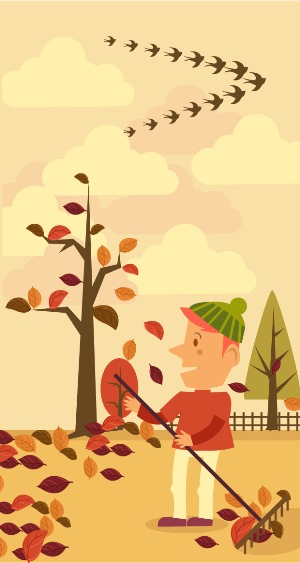 Fall is a great season to spend quality time with family, express gratitude, and switch up your daily routines. Unfortunately, it can also be a time when you experience a lot of fatigue.
Fall is a great season to spend quality time with family, express gratitude, and switch up your daily routines. Unfortunately, it can also be a time when you experience a lot of fatigue.
There are many reasons for this, from getting back to work and your normal busy lives after summer, to not spending as much time exercising and being outdoors in the vitamin D.
While you might experience more days where you just want to nap the afternoon away, there are some super easy ways to reduce your fatigue and get things done during the season.
The Importance of Hydration
Everybody needs water to live, but during the fall your need for it may increase. If you feel your mouth is dry and you feel a bit light-headed, then there’s nothing better for quenching that thirst than plain old H2O.
Not only is it important to continue drinking water throughout the fall, but when the weather cools down, don’t assume you don’t still need to hydrate. It is just as important now as when you were dealing with triple-digit Summer heat.
Don’t Get Dehydrated
Avoid things like sodas and artificially sweetened juices because too many carbohydrates can cause a sugar crash. If you find yourself bored with the neutral flavor and feeling of still water, then try sparkling mineral water. It has all the bubbly feeling of soda without all the sugar.
If you need a little bit of flavor to liven it up, then try a tablespoon each of lemon juice and apple cider vinegar.
Take Your Vitamin D
Vitamin D is a crucial nutrient that regulates your body’s absorption of other equally crucial nutrients such as calcium, magnesium, and phosphate.
Calcium and phosphorous are important for strong bones and teeth, and magnesium regulates hundreds of different parts of the body from the central nervous system to the immune
system to the muscles, heart, and bones.
Without it, you would be more susceptible to such debilitating diseases as the rickets, brain disease, osteoporosis, cancer, and heart attacks.
Why You Need Supplements in the Fall
As long as you do not stay out until you start to get a sunburn, sun exposure is a good way to get the vitamin D your body needs. However, with the days getting shorter, it’s important for you to find a way to compensate for the loss of sunlight. Depending on your age, you may need from anywhere between 600 and 800 IUs of Vitamin D every single day.
Foods with Vitamin D
You could always try a vitamin D supplement and see if that helps, but the best way to do this to increase your vitamin and mineral intake the natural way: with food. Foods that are high in vitamin D include, beef liver, cheese, eggs, fish, and whole milk.
Energy-Boosting Superfoods
Fall is the time of the year when many of our nation’s hard-working farmers harvest their crops of fresh fruits and vegetables. There is never a wrong time for eating healthy food, but fall is one of the best times to start eating several superfoods because this is the time of year when they are in season.
It is a good idea to switch up what you eat in the fall. This is going to keep it interesting, plus encourages you to use more superfoods. There are many superfoods to eat year-round, but here are some of the best ones specifically for the fall season:
Apples
One of the best fall superfoods is an apple. The old saying that goes “an apple a day keeps the doctor away” probably became so popular because of the fact that a single medium-size apple has fewer calories and carbs than a single 12-ounce can of cola.
In addition to that, unlike cola, an apple gets some of its carbs from dietary fiber; it also has no cholesterol or sodium, but it is a good source of potassium, vitamin C, and vitamin B6.
Sweet Potato
Another fall superfood that is rich in vitamins, minerals, and other nutrients is the sweet potato. It is more nutritious for you than the the more common white potato because in addition to being an excellent source of fiber, it also contains calcium, iron, phosphorous, riboflavin, vitamin B5, vitamin B6, vitamin E, and vitamin K.
They are also a good way to add a little splash of color to your daily eating regimen. If you really want to have fun with it, then why not try some sweet potato fries? You can usually find them in the vegetable section in a microwaveable plastic bag.
Butternut Squash
Yet another superfood that comes into season in the fall is butternut squash. Not only does it offer a huge number of nutritional benefits, but you can cook this tasty treat in a lot of different ways.
Lower in carbs than either a sweet potato or a white potato, it’s similar to a pumpkin in its taste and texture, but a cup of it gives you more potassium than a whole banana, and it also gives you vitamins A, E, and B-6 in addition to folate, manganese, niacin, panthotenic acid, and thiamine.
You can eat it cubed or make it into soup, whatever
your imagination can think of.
Other Fall Superfoods
While the ones above are the best for reducing fatigue during the season, here are some others to enjoy as well:
- Carrots
- Parsnips
- Leeks
- Pumpkin
- Pears
- Brussels sprouts
- Cranberries
Stay Active Throughout the Season
If you have a workout regime that involves walking and/or running outside, or doing any kind of outside physical activity, then don’t let the drop in temperature slow you down.
If you spend your spring and summer workouts wearing a short-sleeved shirt and shorts but you think winter clothes might be too heavy, then try wearing lightweight long-sleeved workout gear for a change.
If that is not enough to protect your skin from the cold temperatures, then you might want to consider wearing multiple layers. Hopefully, that won’t become a problem until it starts to get closer to winter.
You could exercise indoors if the cold bothers you, but then you would lose the aforementioned benefits you get from being outside in the sun.
How to Stay Motivated
While you might be aware of how important it is to stay active in the fall, being motivated is something else entirely. Here are some quick tips that can help:
- Get your family or friends involved. It is so much easier to stay motivated for regular workouts when others are helping to keep you accountable. Start going to the gym with a friend, go on walks during your lunch break with co-workers, or walk the dog in the evenings with the kids. You can go on family hikes, have living room dance parties, or bring friends to a new fitness class. There are so many options!
- Find new activities for the fall. There is no reason you have to keep doing the same exercise year-round. Use the change of the season as a good reason to find something new. This might mean weekend bike rides to look at the leaves changing, or trying a Zumba class at your gym. Get creative with how you get exercise and have fun with it.
- Turn it into your daily routine. When all else fails, just schedule in your daily activity. Turn it into a daily routine, such as doing yoga in the morning after you write in your journal, or doing a home bodyweight workout in the evenings after dinner is cleaned up. If it is something you do every day, you are much more inclined to keep up with it.
- Make some short-term, achievable goals. Finally, make some exercise goals for the season, and you will be much more motivated. Write these goals in a planner, bullet journal, or Post-It notes you keep on your fridge. Set goals that are easy to achieve and measurable, like SMART goals.
Unplug at Night for Better Sleep
Almost everybody these days uses computer-related technology in some way, shape, or form. Modern-day smartphones are essentially tiny little computers; while the brick-sized cell phones of the 1980s and 1990s only made phone calls, now you can play games, write, and both watch and make movies with them.
And while they can be a useful tool of communication that is becoming more and more essential to have for work, socializing, and even getting from place to place, there is such a thing as using them too much.
Losing Sleep and its Effect on Your Fatigue
Getting enough sleep is essential for making it through the decreasing length of daytime. Every day until the Winter Solstice, which is usually on December 20 or 21, the days keep getting incrementally shorter by a varying amount of time that depends on where you live.
You could be losing anywhere from as little as one and a half minutes a day to as much as much as 15 minutes a day. The closer you live to the Arctic Circle, the more minutes per day you lose from fall to winter.
Start unplugging at night to get better sleep, which means turning off your cell phone (or keeping it away from you if you need it as an alarm clock) and turning off the TV.
Don’t Forget Your Doctor Check-Ups
You should also consider a doctor check-up during the fall season. This is a good time for a physical and to address any concerns you have with your doctor. You can get routine bloodwork and find out if you might be deficient in any nutrients, which may be adding to your fatigue.
There are also some physical conditions that might cause fatigue, like thyroid conditions, hormonal imbalances, nutrient deficiencies, anemia, kidney and liver disease, and many more.
Fall’s ever-decreasing temperature and gradually shortening days may make it a challenge to keep up your energy levels, but it is not an insurmountable challenge.
Things you can do to increase energy include eating a diet that includes plenty of healthy fall superfoods and foods rich in vitamin D, continuing your exercise regimen while adjusting your attire appropriately, drinking enough liquids to stay hydrated, and putting a limit on your use of electronic devices.
When done consistently, all of these good health practices can keep you rested, relaxed, and revitalized every day throughout the year.




